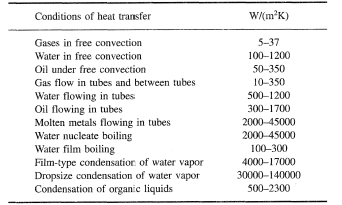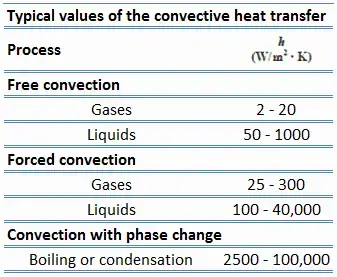Heat Transfer Coefficient Units
Common units used to measure the convective heat transfer coefficient are. The value of the Convective heat transfer coefficient hc depends on the type of media gas or liquid Flow velocity and temperature difference.

Overall Heat Transfer Coefficient Table Charts And Equation
The heat transfer convection coefficient for air is 50 Wm 2 K.

. A heat exchanger is a system used to transfer heat between a source and a working fluidHeat exchangers are used in both cooling and heating processes. The heat transfer coefficient or film coefficient or film effectiveness in thermodynamics and in mechanics is the proportionality constant between the heat flux and the thermodynamic driving force for the flow of heat ie the temperature difference ΔT. A thin metal plate of 4 cm diameter is suspended in atmospheric air whose temperature is 290 K.
The overall heat transfer rate for combined modes is usually expressed in terms of an overall conductance or heat transfer. The concept of heat transfer coefficient is also used in heat transfer with phase transformations in liquid boiling condensation. In systems involving heat transfer a condenser is a heat exchanger used to condense a gaseous substance into a liquid state through cooling.
Where is the work performed on the working fluid by the heat pumps compressor. Formula for Convective heat transfer coefficient Calculation. The surface temperature is 50 o C the fluid temperature is 20 o C and the convective heat transfer coefficient is 2000 Wm 2o C.
Inside temperature in the exchanger is 100 o C and outside temperature is 20 o C. The coefficient of performance of a heat pump is greater than unity. Conduction radiation and friction.
This plate attains a temperature of 295 K when one of its faces receives radiant energy from a heat source at the rate of 2 W. Must contain at least 4 different symbols. In so doing the latent heat is released by the substance and transferred to the surrounding environment.
Btu calories or joules. Heat transfer coefficient is the inverse of thermal insurance which is used for building materials R-value and for clothing insulation. A Peltier cooler heater or thermoelectric heat pump is a solid-state active heat pump which transfers heat from one side of the device to the other with consumption of electrical energy depending on the direction of the current.
1 Wm 2 K 085984 kcalh m 2 C 01761. The following article demonstrates how to calculate and compare the U value for the heat transfer of steam and hot water through different. Heat transfer coefficient is the inverse of thermal insulance.
The order of magnitude of heat transfer coefficient for different cases of heat transfer is presented in Table 1. The SI units of heat transfer coefficient is watts per squared meter Kelvin Wm²K. On the other hand heat transfer resistance is higher for the convective heat transfer and inversely proportional to the related heat transfer coefficient.
Heat is measured in units. The convective heat transfer coefficient is sometimes referred to as a film coefficient and represents the thermal resistance of a relatively stagnant layer of fluid between a heat transfer surface and the fluid medium. D is the thickness of the body.
Q 2000 Wm 2o C 1 m 1 m. A is the area of heat transfer. H fracQDelta T Therefore the SI unit of convection coefficient is Wm2K.
The over all heat transfer coefficient U This takes into account both conductive and convective resistance between two fluids separated by a solid wall. Such an instrument is also called a. The overall heat transfer coefficient is the reciprocal of the overall resistance to heat transfer which is.
This is used for building materials R-value and for clothing insulation. For the convection equation unit we have the following heat transfer coefficient formula. Overall Heat Transfer Coefficient -.
Example - Convective Heat Transfer. In this case the liquid temperature is characterized by the saturation temperature T s. In thermodynamics heat is energy in transfer to or from a thermodynamic system by mechanisms other than thermodynamic work or transfer of matter eg.
Condensers are used for efficient heat rejection in many industrial systems. ASCII characters only characters found on a standard US keyboard. Where in SI Units.
T cold is the temperature of the cold region. The overall heat transfer coefficient U per unit area can be calculated by modifying 3 to. U c the clean overall heat transfer coefficient based on the outside area of the tube assuming no fouling new heat exchanger Wm 2 o K U d the design overall heat transfer coefficient based on the outside area of the tube taking into account fouling factors for both fluids Wm 2 o K h o outside fluid film coefficient Wm 2 o K h i inside.
Q is the transfer of heat per unit time. Electric current is generated by the flow of negatively charged electrons positively charged holes and positive or negative ions in some cases. A fluid flows over a plane surface 1 m by 1 m.
Where Q conv is the convective heat transfer rate h is the convective heat transfer coefficient in units such as Wm 2 K or Btuhft 2 R A is the surface area of the object being cooled or heated T is the bulk temperature of the surrounding fluid and T s is the surface temperature of the object see Figures 124 and 125The algebraic sign of Newtons Law of Cooling is. U 1 1 h ci s k 1 h co 3b The overall heat transfer coefficient for heat exchanger in. The heat transfer coefficient has SI units in watts per squared meter kelvin.
The kind of convective heat transfer forced convection or natural at floor wall or ceilingmust be considered and taken into account by selecting appropriate values for the convective heat transfer coefficient 19 see Eq. In physics and electrical engineering a conductor is an object or type of material that allows the flow of charge electric current in one or more directionsMaterials made of metal are common electrical conductors. They are widely used in space heating refrigeration air conditioning power stations chemical plants petrochemical plants.
K is the thermal conductivity of the body. Heat is a kinetic energy parameter as a result of the motion of the particles in the system. Ground source heat pumps GSHPs or geothermal heat pumps GHP as they are commonly termed in North.
6 to 30 characters long. Is the instantaneous coefficient of performance for the heat pump at the temperatures prevailing in the reservoirs at one instant. Convective Heat Transfer coefficient for Air.
The convective heat transfer between the hotter surface and the colder air can be calculated as. If heat transfer coefficient on both surfaces of the plate is stated to be 875 Wm 2 K workout the reflectivity of the plate. Like thermodynamic work heat transfer involves the surroundings of a system as well as the system itself and so is not a property of the system alone though it contributes to.
A ground source heat pump also geothermal heat pump is a heatingcooling system for buildings that uses a type of heat pump to transfer heat to or from the ground taking advantage of the relative constancy of temperatures of the earth through the seasons. Hence it can be seen that most of the heat transfer resistance is contributed by heat transfer on air side of the pipe which has the lowest heat transfer coefficient. The fluids may be separated by a solid wall to prevent mixing or they may be in direct contact.
Natural Convection 5 25 Wm² K. The overall heat transfer coefficient or U-value refers to how well heat is conducted through over a series of resistant mediums. Thermoelectric cooling uses the Peltier effect to create a heat flux at the junction of two different types of materials.
T hot is the temperature of the hot region. Condensers can be made according to numerous. Its units are the Wm 2 C Btuhr-ft 2 F.
It is used in calculating the heat transfer typically by convection or phase transition between a fluid and a solid. Is the heat transferred from the lower-temperature reservoir to the higher-temperature reservoir. The coefficient of thermal conductivity shows that a metal body conducts heat better when it comes to.
Thus the heat transfer coefficient implicitly assumes the flow situation at the surface. Forced Convection 10 200 Wm² K.

What Is Convective Heat Transfer Coefficient Definition

Cfd Heat Transfer Coefficient Htc In Ansys Fluent Openfoam And Cfx Youtube

Estimates For Heat Transfer Coefficients Youtube

What Is Convective Heat Transfer Coefficient Definition
0 Response to "Heat Transfer Coefficient Units"
Post a Comment